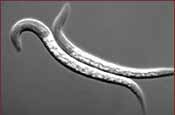Led by Dr. Angela Brooks-Wilson, Senior Scientist at the BC Cancer Agency's Genome Sciences Centre, and Dr. Donald Riddle, Professor of Biology at the University of Missouri, the team prepared SAGE (serial analysis of gene expression) libraries from roundworms that contained a mutated form of the daf-2 gene, which is a principal lifespan-determining factor in C. elegans. Worms that lack fully functional daf-2 exhibit significantly extended lives, persisting approximately twice as long as their wild-type counterparts. Signs Of Aging: Scientists Evaluate
Genes Associated With LongevityDaf-2 was first reported as a critical aging-associated gene in 1993, but since that time, scientists have identified dozens of additional genes that are crucial for longevity. "Aging is a complex process," explains Dr. Brooks-Wilson. "It is commonly believed that a variety of genes and metabolic pathways contribute to the deterioration of cells, tissues and organisms during aging."
In an effort to perform a comprehensive analysis of gerontology-related genes, the researchers compared gene-expression libraries obtained from daf-2 mutants to those obtained from controls at different ages. They predicted that genes exhibiting coordinated up- or down-regulation from early to late adulthood would be those most critical to the vital biological process of aging. In addition, they reasoned that some of the genes that were differentially expressed between daf-2 mutants and controls would also be associated with longevity. Most strikingly, the scientists observed that during the early and mid-life adult stages of daf-2 mutants, genes associated with metabolic processes exhibited repressed expression. This 'hypo-metabolic' state, which involved major lipid, nucleic acid, protein, and energy pathways, became less pronounced with advanced age. "We speculate that the apparent metabolic repression in early and mid-life adults contributes substantially to the observed longevity of daf-2," says Dr. Julius Halaschek-Wiener, a researcher at the BC Cancer Agency's Genome Sciences Centre and first author on the study.
Another notable observation was that stress-response factors such as hsp, mtl-1, gst-1, and sip-1 were more abundantly expressed in the aging adult worms as compared to the early and mid-life adults. These genes were also differentially expressed between daf-2 mutants and controls, consistent with current theories that protection against cellular stress is associated with increased lifespan.
The researchers hope that their observations in C. elegans will contribute to our understanding of human aging. "Many processes involved in nematode aging may have fundamental and analogous roles in humans," Dr. Brooks-Wilson explains. "The human orthologs of some gene family members identified in this study have been associated with human age-related diseases."
SAGE involves the isolation of short gene-specific sequence tags and provides an unbiased and quantitative measurement of gene-expression differences. This study was the first to utilize SAGE to analyze aging-related gene-expression changes. It is expected that the large volume of SAGE data generated for this study will also be utilized to more fully annotate the C. elegans transcriptome, resulting in a refined estimate of gene number and organization in this species.
HOME
Klotho
Resveratrol
Immortality?
Living Longer
Selegiline.com
Living Forever?
Immortal Youth?
Longevity Genes
Supercentenarians
Reengineering the body?
Caloric restriction prolongs life
New treatments for aging brains
World's Oldest Supercentenarians

